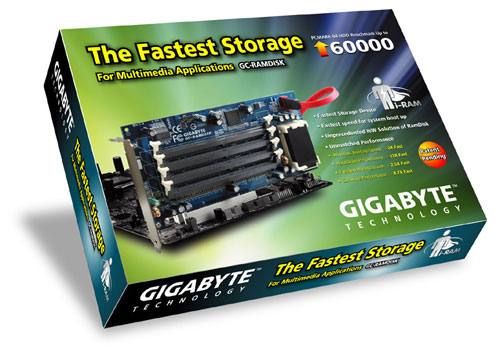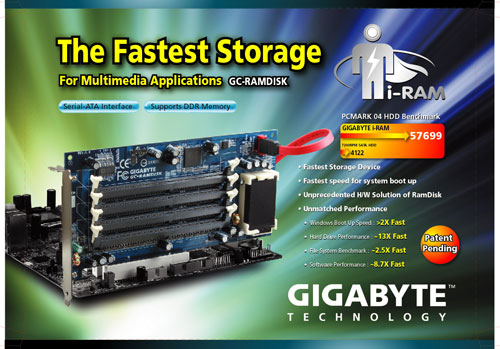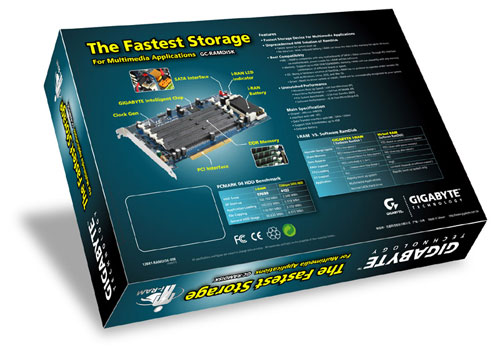Gigabyte's i-RAM: Affordable Solid State Storage
by Anand Lal Shimpi on July 25, 2005 3:50 PM EST- Posted in
- Storage
For years now, motherboard manufacturers have been struggling to find other markets to branch out to, in an attempt to diversify themselves, preparing for inevitable consolidation in the market. Every year at Computex, we'd hear more and more about how the motherboard business was getting tougher and we'd see more and more non-motherboard products from these manufacturers. For the most part, the non-motherboard products weren't anything special. Everyone went into making servers, then multimedia products, then cases, networking, security, water cooling; the list goes on and on.
This year's Computex wasn't very different, except for one thing. When Gigabyte showed us their collection of goodies for the new year, we were actually quite interested in one of them. And after we posted an article about it, we found that quite a few of you were very interested in it too. Gigabyte's i-RAM was an immediate success and it wasn't so much that the product was a success, but it was the idea that piqued everyone's interests.
Pretty much every time a faster CPU is released, we always hear from a group of users who are marveled by the rate at which CPUs get faster, but loathe the sluggish rate that storage evolves. We've been stuck with hard disks for decades now, and although the thought of eventually migrating to solid state storage has always been there, it's always been so very distant. These days, you can easily get a multi-gigabyte solid state drive if you're willing to spend the tens of thousands of dollars it costs to get one; prices actually vary from the low $1000s to the $100K range for solid state devices, obviously making them impractical for desktop users.
The performance benefits of solid state storage have always been tempting. With no moving parts, reliability is improved tremendously, and at the same time, random accesses are no longer limited by slow and difficult to position read/write heads. While sequential transfer rates have improved tremendously over the past 5 years, thanks to ever increasing platter densities among other improvements, it is the incredibly high latency that makes random accesses very expensive from a performance standpoint for conventional hard disks. A huge reduction in random access latency and increase in peak bandwidth are clear performance advantages to solid state storage, but until now, they both came at a very high price.
The other issue with solid state storage is that DRAM is volatile, meaning that as soon as power is removed from the drive, all of your data would be lost. More expensive solutions get around this by using a combination of a battery backup as well as a hard disk that keeps a backup of all data written to the solid state drive, just in case the battery or main power should fail.
Recognizing the allure of solid state storage, especially to performance-conscious enthusiast users, Gigabyte went about creating the first affordable solid state storage device, and they called it i-RAM.
Through some custom logic, the i-RAM works and acts just like a regular SATA hard drive. But how much of a performance increase is there for desktop users? And is the i-RAM worth its still fairly high cost of entry? We've spent the past week trying to find out...
This year's Computex wasn't very different, except for one thing. When Gigabyte showed us their collection of goodies for the new year, we were actually quite interested in one of them. And after we posted an article about it, we found that quite a few of you were very interested in it too. Gigabyte's i-RAM was an immediate success and it wasn't so much that the product was a success, but it was the idea that piqued everyone's interests.
Pretty much every time a faster CPU is released, we always hear from a group of users who are marveled by the rate at which CPUs get faster, but loathe the sluggish rate that storage evolves. We've been stuck with hard disks for decades now, and although the thought of eventually migrating to solid state storage has always been there, it's always been so very distant. These days, you can easily get a multi-gigabyte solid state drive if you're willing to spend the tens of thousands of dollars it costs to get one; prices actually vary from the low $1000s to the $100K range for solid state devices, obviously making them impractical for desktop users.
The performance benefits of solid state storage have always been tempting. With no moving parts, reliability is improved tremendously, and at the same time, random accesses are no longer limited by slow and difficult to position read/write heads. While sequential transfer rates have improved tremendously over the past 5 years, thanks to ever increasing platter densities among other improvements, it is the incredibly high latency that makes random accesses very expensive from a performance standpoint for conventional hard disks. A huge reduction in random access latency and increase in peak bandwidth are clear performance advantages to solid state storage, but until now, they both came at a very high price.
The other issue with solid state storage is that DRAM is volatile, meaning that as soon as power is removed from the drive, all of your data would be lost. More expensive solutions get around this by using a combination of a battery backup as well as a hard disk that keeps a backup of all data written to the solid state drive, just in case the battery or main power should fail.
Recognizing the allure of solid state storage, especially to performance-conscious enthusiast users, Gigabyte went about creating the first affordable solid state storage device, and they called it i-RAM.



Through some custom logic, the i-RAM works and acts just like a regular SATA hard drive. But how much of a performance increase is there for desktop users? And is the i-RAM worth its still fairly high cost of entry? We've spent the past week trying to find out...










133 Comments
View All Comments
- Tuesday, July 26, 2005 - link
I was really surprised at how little it helped as a page file. Myself I sometimes encounter periods of slowdown due to paging that can last for several minutes where nothing can be done. I don't know if there's a common name for this but I'll call it the "page file wall". I don't know exactly how you would recreate such a tragedy in the lab. Too many apps open with too little memory obviously. But less obviously, it seems that during a period of overnight inactivity (with apps left open) windows will page a lot of stuff out to disk and you can experience the page file wall the next morning. It'd be interesting if Anand could devise a consistent "page file wall" benchmark.
As the article and many posts above suggest doubling my RAM would probably end my problems.
I still think this product (or revision 2 or 3) could bridge an obvious gap with PC's: SLOW harddisks and EXPENSIVE ram. When you run out of ram it can be like hitting a wall. It can be like crossing the country, but you go half by jet and the other half on foot. The gap should be filled with something cheaper than modern DDR and faster than harddisks. (This product is barely either.) I'd like to see a PC with 1 GB normal ram and 2GB of cheap-o 1/8 speed auxiliary ram. The OS could use this slower ram for paging with priority over paging to the harddisk. Not just for enthusiasts, but for regular beige PC's. Owners would then have another upgrade option with a better cost/benefit ratio depending on their needs.
I was waiting for a performance review of this thing and I'm so glad trusty Anandtech provided.
BTW: Long time reader (4+years), 1st time poster.
- Tuesday, July 26, 2005 - link
I was in my local computer shop and the guy working there pointed at a stack of hardware and said some guy just dropped $8000 on a Intel 955X or whatever system that included around 16 gigs of Ram disks and I asked if it was based on ddr400 and he said no it was in fact ddr2 533 I think. A quick search on the internet found nothing about ddr2 ram drives and it defies logic to me anyway since i would think that ddr 400 would be faster due to latency issues, etc. Has anyone heard anything like this? Also the guy at the store told me that it boots in to Windows XP in 4 seconds. It sounds like a tall tale but i don't see any reason why he would be making it up as they are pretty reputable.davidlang - Tuesday, July 26, 2005 - link
where you really suffer is on writes.any time you need to write something before you can continue the latency becomes critical. Database writes (and logging) are a perfect example of this.
Under *nix the Journal of a journaling filesystem is performance critical (although it's useually a sequential write so it is about as good as you can get.
For Database engines that have good crash recovery (MySQL is not that good at this, but Postgres or Oracle are) they need to make sure that their log gets to a safe storage media before they can consider the write completed and tell the caller that it's done.
even for an apache webserver, with normal logging apache will not return the page until the log has been written.
somu - Tuesday, July 26, 2005 - link
As a lot of ppl have posted here, it would make sense to use this as a cache for our harddrives by making it possible to plug the harddrive into the i-ram and i-ram to the motherboard. This would overcome the 4gb limitation and we probably wouldnt need the full 4gb for cache we can use like 1gb or 2 gb. But to see more increase in performance they will need to move it to sata2 and have programmers write into their code to precache data to take full advantage of the i-ram.AngleRider - Tuesday, July 26, 2005 - link
Well it seems that modern hard drives are getting alot faster and solid state doesn't seem to help as much as it would of say, 2 or 4 years ago when we were running crusty low density HDs...
However, I am also slighty disappointed in the design...
Why put main system memory in a drive and then limit it to SATA I (not SATA2)?
I thought the whole point of a ram drive was provide maximum i/o performance...??
Second not allowing 2GB sticks doesn't make sense to me... i mean 4gb is really small.
Maybe they should of thought this,
"Gee, let's try to offer more capacity - like, golly bunny, currently available 2gb ram modules..."
Even so, if this can do 591% higher i/o performance than a raptor in ipeak business winstone, then i'm sure there are ways to utilize this in computing tasks...
Also if u put the os on it u wont ever need to defrag...
Nice, but expensive for now ... expensive doesn't mean its crap.. just weakly spec'd to my mind for now...
Why do something like this and then water it down?
D
UNCjigga - Tuesday, July 26, 2005 - link
I think the disappointing benchmarks ought to say something about current OS's suitability to the iRAM, and not iRAM's capabilities. I really think this is an idea ahead of its time. Windows XP isn't tuned for solid-state storage, the FPGA chip on the iRAM isn't the best solution, and the SATA interface itself is a bottleneck. If Windows Vista and future BIOSes had support for PCIe storage, imagine a version of iRAM that had a straight PCIe interface supporting the full 1.6Gb/s or more depending on the type of memory you put on, and 8Gb or more memory thanks to 64bit addressing.Windows Vista will already have support for hybrid drives (NAND+platter) so the caching and paging routines will be optimized for solid-state storage. I actually think iRAM might be better than hybrid drives because 1) you can use existing drives with it, 2) iRAM is expandable (up to a limit), 3) DDR is faster than NAND
shaw - Tuesday, July 26, 2005 - link
I could see SATA II could remove the bottleneck, but still, 4GB of data? Gigabyte is smarter then this.. it's just not going to fly. Though, it is a pretty good start.The next logical steps is probably finding a way to get a standard harddrive to use something like this as a memory buffer (7200rpm with DDR200 1GB of cache) and then maybe it would actaully be worth it.
JNo - Tuesday, July 26, 2005 - link
I was disappointed that nothing was mentioned of the practicalities of moving windows or a game onto this thing. Is there any software that would transfer whatever data is on this thing (including functioning operating systems) to a normal drive at regular intervals? And keep them functioning? If not, what's the point?! Each time you have to install windows/a game to this thing (after powerfailures or just for the sake of having something different on it), you have to install all the updates/personal tweaks/mods/saved games/configurations etc which would takes SO MUCH MORE TIME than the extra few seconds you save from faster boot/game load times... why anandtech does not take these things into consideration?! To paraphrase another poster: WHOOPEE-F*CKING-DOaraczynski - Tuesday, July 26, 2005 - link
disappointing gaming benefits, too small a size, they should've used a custom controller rather then the connect-the-dots one.i'll be waiting to see what version 3 brings.
EODetroit - Tuesday, July 26, 2005 - link
The $150 thing is a killer. But if they can only pump out 1000 of them, it makes business sense to have the price high. This just like AMD having high X2 prices because they can't possibly make enough quantity to fill orders if the price was lower... same exact thing.$90 per 1GB stick of ram is high, I'm sure people can shop around and find it cheaper.
As for RAIDing two of these, Anand said he only actually had one of them, but was trying to get a second. So maybe more on that later. I think that even if Raid 0 doesn't work for some reason, JBOD would work.
I'm curious what the bottleneck in computers now-a-days really is. I think Anand should get an NForce Pro with 8 GB of ram running 64bit XP, set up the largest RAM DISK (real software-type RAM disk) you can, and see how that affects performance. If performance shows the same mediocre gains that this device showed, then that means a new SATA2 version wouldn't improve things either. If that test showed there were large gains out there to be had, then yeah there's a future here. I would do it myself but I don't have access to that hardware hehe.